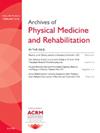Psychometric Properties and Clinical Utility of the Boston Cognitive Assessment (BOCA) on an Acute Rehabilitation Unit
IF 3.6
2区 医学
Q1 REHABILITATION
Archives of physical medicine and rehabilitation
Pub Date : 2025-04-01
DOI:10.1016/j.apmr.2025.01.082
引用次数: 0
Abstract
Objectives
To elucidate the psychometric properties of the Boston Cognitive Assessment (BOCA) in a sample of inpatients in an Acute Rehabilitation Unit (ARU). To introduce the clinical utility of the BOCA, a digital cognitive screen on an ARU.
Design
Retrospective cross-sectional design.
Setting
Acute Rehabilitation Unit at a free-standing, 138-bed inpatient medical rehabilitation hospital.
Participants
Hospital records from 32 patients were identified wherein individuals completed the BOCA and Montreal Cognitive Assessment (MoCA). Admission diagnoses included neurological and nonneurological injuries.
Interventions
The BOCA and MoCA test administration were 10 and 15 minutes, respectively. BOCA Total Score and individual subtest scores were examined, along with demographic and clinical variables. Exploratory factor analysis, internal consistency, concurrent validity, and known-group validity were examined.
Main Outcome Measures
The BOCA is a computerized, self-administered measure of global cognition (Gold et al., 2021; Vyshedskiy et al., 2022) and evaluates immediate recall, delayed recall, language reasoning, visuospatial reasoning, executive functioning, attention, mental math, and orientation. The MoCA is a paper-and-pencil screening instrument for cognition (Nasreddine, 2005) and evaluates wordlist recall, visuospatial and executive functions, language, attention, and orientation. For both measures, the maximum score is 30; lower scores reflect greater cognitive difficulties.
Results
Average age was 59.13 years (SD, 16.49y; range, 25-85y). Average years of education was 14.9 years (SD, 3.46y). Average BOCA total score was 25.13 (SD, 4.46) and average MoCA total score was 23.44 (SD, 4.59). Similar to studies of outpatients, the BOCA demonstrated a unitary factor structure accounting for a plurality of the variance, adequate internal consistency (a=0.73), and strong concurrent validity with the MoCA (r=0.57; P=.003). This study explored differences in BOCA performance among those admitted with primary brain injuries compared with those admitted for nonneurologic conditions. Those admitted to the ARU with brain injuries scored significantly lower than those admitted for nonneurological etiologies (U=67.50, P=.025).
Conclusions
There is increasing need to access novel and efficient cognitive screening tools within an inpatient rehabilitation setting. This study provides initial evidence that the BOCA maintains similar factor structure, reliability, and validity in inpatient samples compared with what has been observed in outpatient samples. These findings provide preliminary support for deploying the BOCA in inpatient settings. The BOCA is a useful screening instrument for assessing cognition in neurologic patients within an ARU, with ease of administration, short administration time, and clinically useful data to aid clinical decision making. Clinical utility of the BOCA, limitations, and directions for future research are discussed.
Disclosures
none.
波士顿认知评估(BOCA)在急性康复病房的心理测量特性和临床应用
目的探讨急性康复科(ARU)住院患者波士顿认知评估(BOCA)的心理测量特征。介绍ARU上的数字认知屏幕BOCA的临床应用。设计回顾性横断面设计。在独立的、有138张床位的住院医疗康复医院设置急症康复科。来自32名患者的医院记录被确定,其中个人完成了BOCA和蒙特利尔认知评估(MoCA)。入院诊断包括神经和非神经损伤。干预措施BOCA和MoCA给药时间分别为10分钟和15分钟。检查BOCA总分和个体亚测试分数,以及人口统计学和临床变量。考察了探索性因子分析、内部一致性、并发效度和已知组效度。BOCA是一种计算机化的、自我管理的全球认知测量(Gold et al., 2021;Vyshedskiy等人,2022),并评估即时回忆、延迟回忆、语言推理、视觉空间推理、执行功能、注意力、心理数学和定向。MoCA是认知的纸笔筛选工具(Nasreddine, 2005),评估词表回忆、视觉空间和执行功能、语言、注意力和定向。两项测试的最高分都是30分;较低的分数反映出更大的认知困难。结果患者平均年龄59.13岁(SD, 16.49y;范围内,25 - 85 y)。平均受教育年限为14.9年(SD, 3.46y)。平均BOCA总分为25.13分(SD, 4.46),平均MoCA总分为23.44分(SD, 4.59)。与门诊病人的研究相似,BOCA表现出单一的因素结构,可以解释多个方差,具有足够的内部一致性(a=0.73),并且与MoCA具有较强的并发效度(r=0.57;P = .003)。本研究探讨了原发性脑损伤患者与非神经系统疾病患者在BOCA表现上的差异。因脑损伤而入住ARU的患者得分明显低于因非神经病因入住的患者(U=67.50, P= 0.025)。结论在住院康复环境中,越来越需要使用新颖有效的认知筛查工具。本研究提供的初步证据表明,与在门诊样本中观察到的结果相比,住院样本中的BOCA保持了相似的因素结构、信度和效度。这些发现为在住院环境中部署BOCA提供了初步支持。BOCA是一种有用的筛查工具,用于评估ARU内神经系统患者的认知能力,易于使用,给药时间短,临床有用的数据有助于临床决策。讨论了BOCA的临床应用、局限性和未来研究方向。
本文章由计算机程序翻译,如有差异,请以英文原文为准。
求助全文
约1分钟内获得全文
求助全文
来源期刊
CiteScore
6.20
自引率
4.70%
发文量
495
审稿时长
38 days
期刊介绍:
The Archives of Physical Medicine and Rehabilitation publishes original, peer-reviewed research and clinical reports on important trends and developments in physical medicine and rehabilitation and related fields. This international journal brings researchers and clinicians authoritative information on the therapeutic utilization of physical, behavioral and pharmaceutical agents in providing comprehensive care for individuals with chronic illness and disabilities.
Archives began publication in 1920, publishes monthly, and is the official journal of the American Congress of Rehabilitation Medicine. Its papers are cited more often than any other rehabilitation journal.

 求助内容:
求助内容: 应助结果提醒方式:
应助结果提醒方式:


